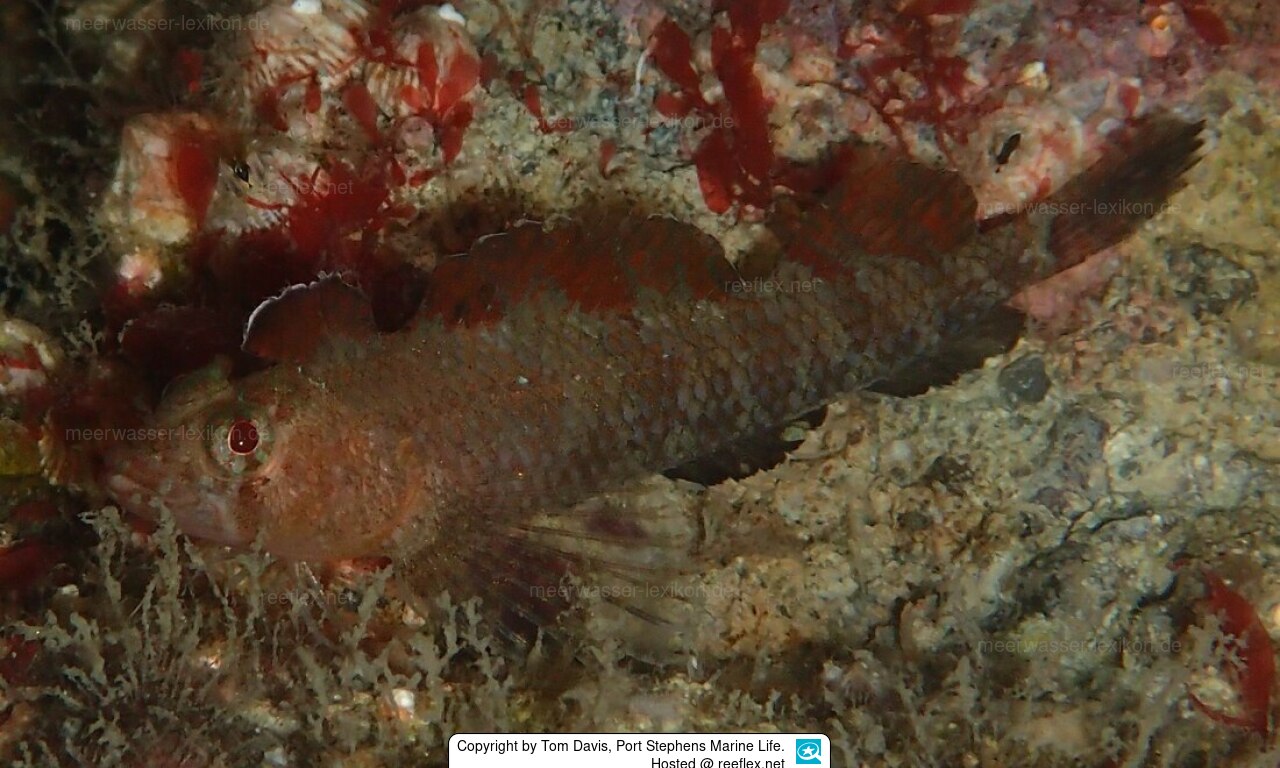Info
The genus name "Norfolkia" refers to the discovery of the blenny Norfolkia squamiceps around Norfolk Island, which lies in the Pacific Ocean in a triangle between eastern Australia, New Caledonia to the north and New Zealand to the south, but this island belongs to Australia.
The species was not named in honour of a deserving scientist, but after the Leeuwin Current, a warm ocean current that flows south near the west coast of Australia.
Norfolkia squamiceps is a pale grey to brown three-fin blenny with an oblique darker reddish-brown bar outlined in white below the eye, uneven brown spots in two series along the side (the upper series is larger and sometimes connected to the lower series), yellow to orange dorsal and caudal fins and a dark brown head that becomes whitish below.
The white-spotted pectoral fins of the blenny have two elongated rays.
Females have oblique dark bands on the second and third dorsal fins and uneven dark vertical stripes on the caudal fin.
Males can be recognised by yellow or orange dorsal and caudal fin lighter.
The three-finned blenny prefers tide pools and shallow areas on clear coral and rocky reefs.
Synonyms:
Gillias squamiceps McCulloch & Waite, 1916
Norfolkia lairdi Fowler, 1953
Jumping guard
A jumping guard prevents (nocturnal) fish from jumping out.
Wrasses, blennies, hawkfishs and gobies jump out of an unprotected tank in fright if their night rest is disturbed, unfortunately these jumpers are found dried up in the morning on carpets, glass edges or later behind the tank.
https://www.korallenriff.de/en/article/1925_5_Jump_Protection_Solutions_for_Fish_in_the_Aquarium__5_Net_Covers.html
A small night light also helps, as it provides the fish with a means of orientation in the dark!
The species was not named in honour of a deserving scientist, but after the Leeuwin Current, a warm ocean current that flows south near the west coast of Australia.
Norfolkia squamiceps is a pale grey to brown three-fin blenny with an oblique darker reddish-brown bar outlined in white below the eye, uneven brown spots in two series along the side (the upper series is larger and sometimes connected to the lower series), yellow to orange dorsal and caudal fins and a dark brown head that becomes whitish below.
The white-spotted pectoral fins of the blenny have two elongated rays.
Females have oblique dark bands on the second and third dorsal fins and uneven dark vertical stripes on the caudal fin.
Males can be recognised by yellow or orange dorsal and caudal fin lighter.
The three-finned blenny prefers tide pools and shallow areas on clear coral and rocky reefs.
Synonyms:
Gillias squamiceps McCulloch & Waite, 1916
Norfolkia lairdi Fowler, 1953
Jumping guard
A jumping guard prevents (nocturnal) fish from jumping out.
Wrasses, blennies, hawkfishs and gobies jump out of an unprotected tank in fright if their night rest is disturbed, unfortunately these jumpers are found dried up in the morning on carpets, glass edges or later behind the tank.
https://www.korallenriff.de/en/article/1925_5_Jump_Protection_Solutions_for_Fish_in_the_Aquarium__5_Net_Covers.html
A small night light also helps, as it provides the fish with a means of orientation in the dark!







 Tom Davis, Australien
Tom Davis, Australien




